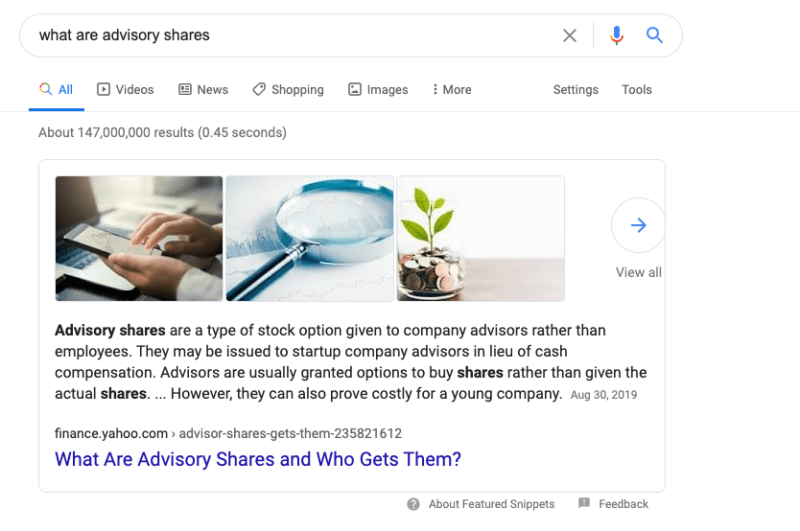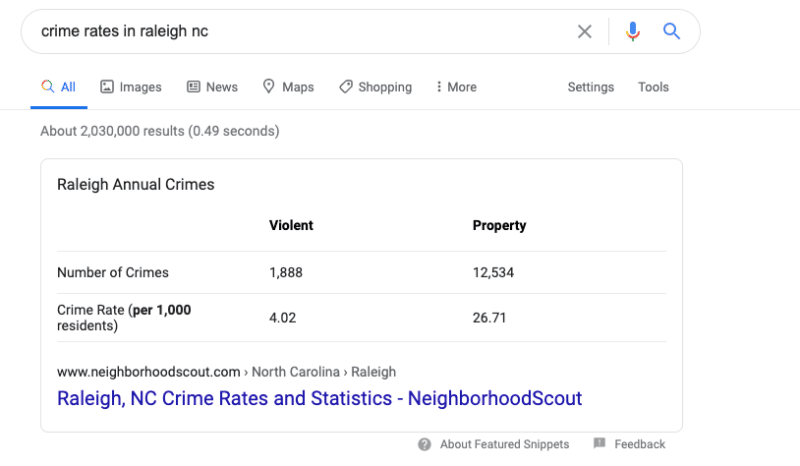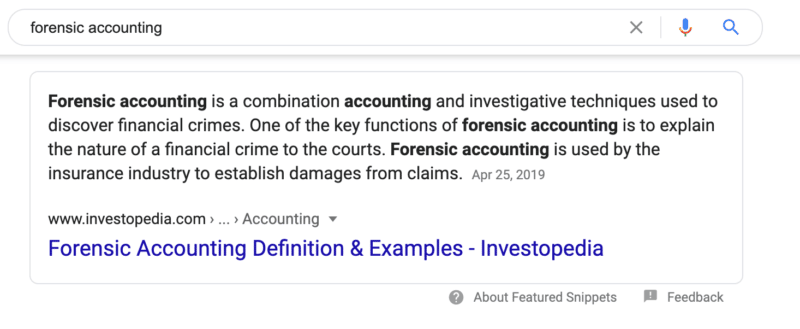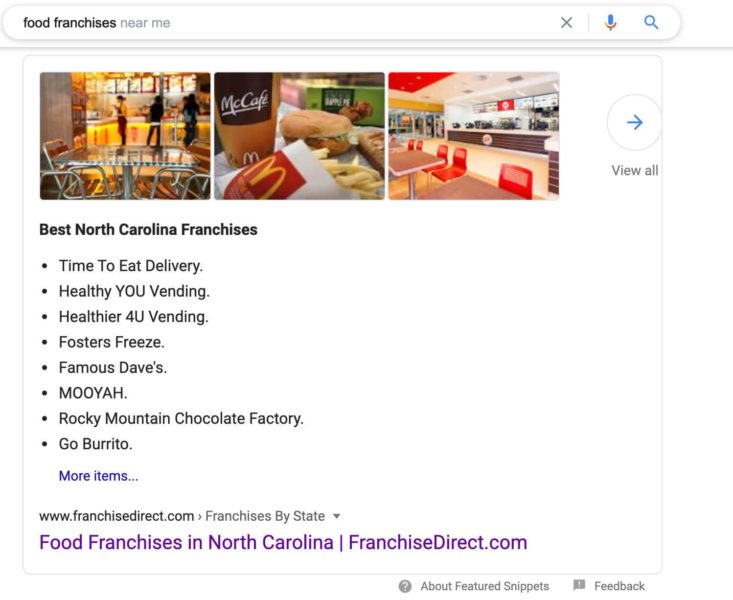The featured snippet is still one of the SERPs’ most coveted pieces of real estate. They allow your site to quickly jump to the top of the search results, even if the “traditional rankings” would place your site at the bottom of the first page.
My team and I have had a lot of success optimizing for featured snippets over the years. Eventually, we developed our internal frameworks for what performs best in claiming these yearned-for positions.
Below are the strategies we use to optimize for featured snippet results.
What is a featured snippet?
A featured snippet is a two- to three-sentence summary of text that appears at the top of Google. Featured snippets directly answer a user’s query in the search results. Receiving a featured snippet can result in more traffic for a given page.
Featured snippet optimization
Follow these steps to optimize for featured snippets::
- Add a “What is” heading.
- Use an “is” sentence structure.
- Fully define the topic.
- Match the featured snippet format.
- Don’t use your brand name.
- Don’t use first-person language.
- Scale featured snippets.
- Prioritize when you rank in the top five.
- Iterate your optimizations.
The featured snippet appears to work on a more simplistic algorithm than Google’s “primary” one. The featured snippet is much more influenced by simple on-page adjustments that clearly define the topic to users.
Featured snippets and voice search
Also, remember that one of the goals of the featured snippet is to fuel voice search.
Google reads back featured snippets when users perform voice queries on mobile or Google Home devices. This means that featured snippets must always make sense in this context.
When optimizing for featured snippets, it makes sense to ask yourself, “How would my answer sound if it was read back on voice search?”
The types of featured snippets
You might notice there are several kinds of featured snippets. Knowing each type is important to understand how to structure your content to optimize for them.
What follows are the most common types of featured snippets.
Paragraph
The most common type of featured snippet, the paragraph is composed of two or three sentences of text pulled from a <p> HTML element.

List
A bulleted or numbered list generally pulled from either an <ol> or <ul> HTML element.

Table
A table of information pulled from a <table> HTML element. This is the least common type of featured snippet.

How to optimize for Google's featured snippets
Throughout the years, one of the things I've been able to hone in on is how to optimize for the featured snippet.
I've developed a set of rules to follow when optimizing client pages for this SERP feature. You can learn more about each rule below.
1. Add a 'What is' heading
To start your featured snippet optimizations, you'll want to look for a place in your content to add a "What is [keyword]" heading tag. This signals to Google that your upcoming text could be helpful as a featured snippet.
Countless examples of pages get the featured snippet using this heading format. We've seen good success rates when replicating this strategy for our clients.
Ideally, you'll add this heading as close to the top of your content as possible. If writing a blog post, I'll generally add it right below the introductory paragraph. This is often a great place to add it because it flows well with the content while allowing you to include it near the top of the page.
For instance, here's a great example from TechnologyAdvice. We can see that they include this section right below their "Table of contents" at the top of the page:

Adding this section gives Google a clear indication of what text they can pull into the featured snippet.
As a result, they received the answer box for the competitive keyword "project management software" and even outranked Capterra, which is tough to do in SaaS SEO.

2. Use the 'is' sentence structure
When optimizing for the featured snippet, it's important to include an "is" statement.
The first sentence should start with the structure: "[Keyword] is…"
Below are some examples from results getting the featured snippet:
- "Agile methodology is a type of project management process, mainly used for software development…"
- "Customer relationship management (CRM) software is software that automates and manages the customer life cycle of an organization."
- "Return on Investment (ROI) is a performance measure used to evaluate the efficiency of an investment or compare the efficiency of a number of different investments."
Our analysis of pages receiving featured snippets consistently shows that "is" statements are utilized within the text.
In our experience, this content structure appears to act as a "triggering phrase" allowing Google to easily find relevant text for the featured snippet.
To boost your chances of getting the featured snippet spot, ensure that your first sentence follows this format. By using an "is" statement, you should see a higher percentage of your optimizations result in winning the featured snippet.
3. Fully define the topic in 2-3 sentences
This is the most important rule to follow, in my opinion.
Featured snippets should give users as much information about the topic as quickly as possible.
This means the content you're optimizing must try to describe the topic as completely as possible in two to three sentences. For this rule, being concise is extremely important.
Here are some general guidelines we try to follow when trying to concisely define featured snippets
- The first sentence should define the topic.
- The second and third sentences should describe 2-3 must-know facts about the topic.
- Avoid using any extraneous phrasing in your definition.
Here's a great example from Investopedia:

This follows the above pattern of first describing the topic and then providing users with two must-know facts about it.
- Forensic accounting is a specific accounting technique to discover crimes.
- It's used to provide evidence of financial misconduct to courts.
- Forensic accounting is heavily used in the insurance industry.
Also, notice how the text doesn't use unnecessary words within the definition. It's short and to the point.
4. Match the featured snippet format
As explained earlier, the different types of featured snippets include:
- Paragraphs (most common).
- Bulleted and numbered lists.
- Tables (least common).
This rule is simple. Whatever featured snippet type you see on the SERP, match that type in your content.
For example, if you see a paragraph featured snippet appearing for the term you want to optimize for, you need to find a place to add/adjust two or three sentences of text.
However, if a bulleted list appears, you'll need to add a similar list to your page's content.
5. Never use your brand name in featured snippet text
This is a mistake we see all the time.
A company will get rules 1-4 right but will use some language that makes the result ineligible for the featured snippet. Brand names are one example of such language.
Remember that featured snippets fuel voice search. Devices such as Google Home will directly read what's in the featured snippet to users. This means that the content needs to make complete sense in this context.
For example, say Wegmans was trying to optimize for the featured snippet "health benefits of avocado" and used the following sentence:
- "Avocados from Wegmans have many health benefits as they are a great source of riboflavin, vitamins C and potassium."
When read by a voice assistant, this might be confusing as the searcher was looking for general benefits that apply to all avocados – not just the ones sold by Wegmans.
Replacing the brand name with general language will give the content a higher chance of receiving a featured snippet.
The ideal optimization could look something like this:
- "Avocados have many health benefits as they are a great source of riboflavin, vitamins C and potassium."
6. Don't use first-person language
Similar to the previous rule, using first-person language can be a mistake due to the ramifications of voice search.
In the above example, let's say the on-page text optimized for the featured snippet read:
- "Our avocados have many health benefits. We have avocados that are a great source of riboflavin, vitamins C and potassium."
Again, imagine if this sentence was read by a voice assistant. The user might wonder:
- Who is the "we" that is being referenced?
- Does this information only apply to their product?
This sounds like the information might be specific to a type of avocado and might not apply to the food in general.
Limiting this type of phrasing may also help you improve your chances of receiving a featured snippet.
7. Scale featured snippets when possible
We've seen interesting behavior throughout the years with bulleted list featured snippets.
For instance, you can see that a search for the term "food franchises" yields the following featured snippet below.

However, when looking at the page, there is no specific bulleted list. Instead, the page is set up as a standard ecommerce category page.
What Google appears to be pulling the featured snippets from is actually the individual product listings within the category page, and the selected text all appear to be formatted as H3.

The example shows us that in some results, Google scrapes heading tag information to display as featured snippets. This allows for an interesting opportunity as featured snippets can be scaled with adjustments to the HTML.
We've recommended adjusting the HTML on category pages from standard paragraph tags to H2 or H3 tags for some clients. This might send stronger signals that could scale featured snippet optimization globally.
Take the time to review where Google is pulling your competitors' featured snippets from. If you're seeing common HTML elements, consider adjusting your global templates to give your content the best chance of triggering the featured snippet.
8. Prioritize opportunities where you rank in the top 5
Previous studies have shown that ranking position matters in terms of claiming a featured snippet. Simply put, the higher you rank, the better your chance of claiming one.
An Ahrefs study showed that results ranking in the first position had a 30.9% chance of receiving a featured snippet. Positions 2 and 3 had a 23.5% and 15.9% chance, respectively.

While this data might be different now since deduplication, it still has clear takeaways for SEOs.
The higher your site ranks in the "standard" results, the better the chance of generating a featured snippet.
When prioritizing, look for keywords where you already rank within the top 5 results.
9. Iterate your optimizations
You've followed the steps above.
You've written fantastic on-page content that clearly describes the topic under a dedicated "What is" heading at the top of the page.
You've also been sure to stay clear of any brand or first-person terminology.
You push your optimizations to production and wait for Google to re-index your content.
When Google finally indexes your new changes, your page still isn't generating the featured snippet.
This is not the time to stop optimizing. Instead, iterate your approach and try again. For many of the featured snippets we get, it can take multiple iterations.
In this phase, I've found that using the above process generally gets you 80% of the way there.
If your result still doesn't receive a featured snippet, minor adjustments tend to work well.
Look for opportunities to better define the topic, use even more concise phrasing or test highlighting different facts (see Rule 3).
Start with minor adjustments and work to more major ones if you're still not seeing the desired results.
You'll often find that the featured snippet can be obtained after a few rounds of interaction to perfect the language.
Earn featured snippets and boost your SERP visibility
Hopefully, these guidelines will help you when optimizing for featured snippets.
Remember, it's extremely important to:
- Use an "is" statement.
- Fully define the topic in two to three sentences.
By following the rules above, you should be able to significantly improve how many featured snippets you're able to receive for your site.
The post How to get Google featured snippets: 9 optimization guidelines appeared first on Search Engine Land.
source https://searchengineland.com/google-featured-snippets-optimization-guidelines-389951

0 Comments